
Browse an alphabetical list of photographs. These historical images portray people, places, and events before, during, and after World War II and the Holocaust.
<< Previous | Displaying results 1051-1100 of 2641 for "Photo" | Next >>
Parade of German police before Adolf Hitler in front of Hotel Deutsches Haus, at a Nazi Party Congress rally. Nuremberg, Germany, September 10, 1937.
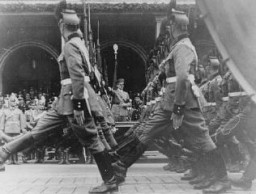
German police round up Jews and load them onto trucks in the Ciechanow ghetto. Ciechanow, Poland, 1941-1942.
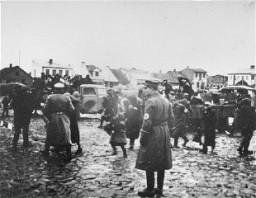
German policemen search an elderly, religious Jew at gunpoint in German-occupied Poland, circa 1941.
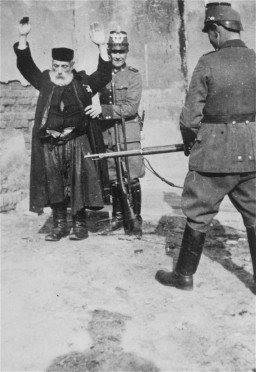
A German policeman interrogates a Jewish man accused of trying to smuggle a loaf of bread into the Warsaw ghetto. Warsaw, Poland, 1942-1943.
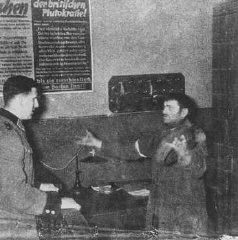
A German postcard showing the entrance to the Lodz ghetto. The sign reads "Jewish residential area—entry forbidden." Signs forbidding entrance to Poles and Germans were posted at all entrances to the ghetto. Lodz, Poland, 1940–1941.
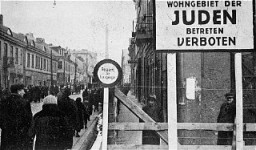
German prisoners file across the Rhine as American supply trucks move forward toward the front. March 26, 1945. US Army Signal Corps photograph.
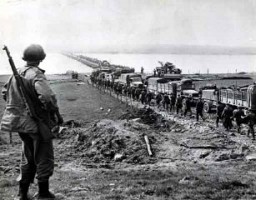
German propaganda photograph of a kindergarten for German infants promotes the nurturing role of women on the home front. Germany, 1941.
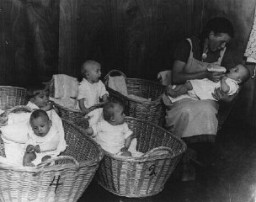
Images from a German publication about the occupation of the Rhineland (1918–1930), a region in western Germany, and multiracial children who were born to white German mothers and Black soldiers there. Publication dated 1936–1939.
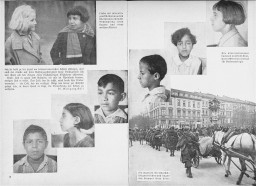
British troops at the site of a former German trench following the withdrawal of German troops to the Hindenburg line on the western front in World War I. This photograph shows a trench bridge over a German trench. Gommecourt, France, 1917.
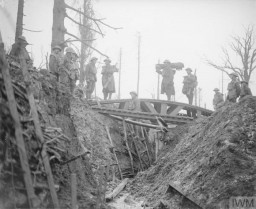
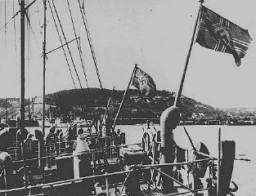
A German soldier guards Soviet prisoners of war at the Uman camp in the Ukraine. Soviet Union, August 14, 1941.
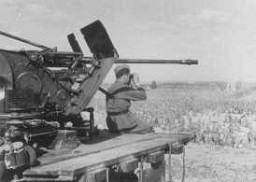
German soldiers capture Jews hiding in a bunker during the Warsaw ghetto uprising. Warsaw, Poland, April–May 1943.

German soldiers execute Piotr Sosnowski, a priest from Tuchola. Piasnica Wielka, Poland, 1939.
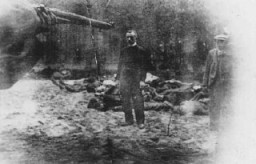
Young German soldiers assist in the deportation of Jews from the Zychlin ghetto to the Chelmno killing center. The Nazis planned this deportation to fall on the Jewish holiday of Purim. Poland, March 3, 1942.
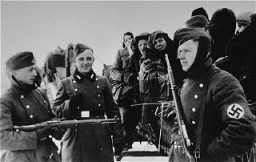
German soldiers guard Soviet prisoners of war marching to camps. Soviet Union, 1941. Second only to the Jews, Soviet prisoners of war were the largest group of victims of Nazi racial policy.
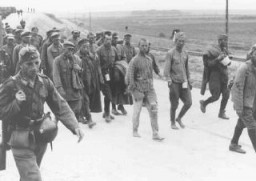
German soldiers hold Poles, including Polish clerics, hostage. Bydgoszcz, Poland, September 9, 1939.
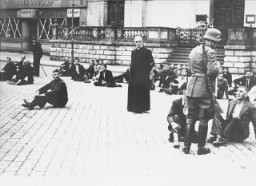
German soldiers in the Argonne Forest, France, during World War I. Photograph taken ca. 1914–1915.
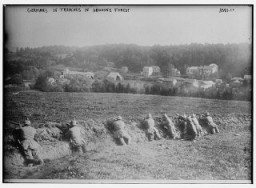
German soldiers in the Soviet Union during a December 1943 Soviet offensive on the eastern front. German troops invaded Soviet territory in June 1941 but faced counteroffensives following the battle of Stalingrad. December 16, 1943.
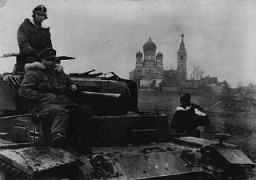
Jews captured by the SS during the Warsaw ghetto uprising are interrogated beside the ghetto wall before being sent to the Umschlagplatz, the assembly point for deportation from the ghetto. The original German caption reads: "Search and Interrogation." Poland, May 1943.
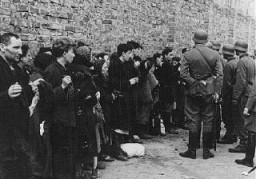
Interrogation of Soviet prisoners of war by German soldiers upon arrival at a prison camp. Lida, Poland, 1941.
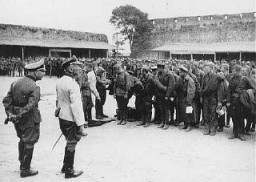
German soldiers lead blindfolded Polish hostages to an execution site. Olkusz, Poland, July 16, 1940.
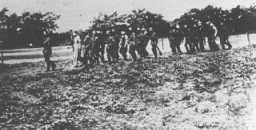
German soldiers parade in Pilsudski Square. Warsaw, Poland, October 4, 1939.
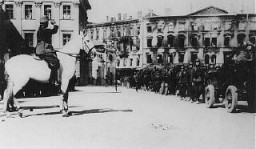
During the Warsaw ghetto uprising, German soldiers round up Jews in factories for deportation. Warsaw ghetto, Poland, April or May 1943.

German tanks pass a burning Russian village during Operation Barbarossa, the invasion of the Soviet Union, in the summer of 1941. © IWM (HU 111382)
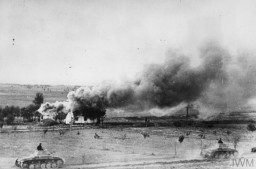
German tanks cross the Czech border, in violation of the 1938 Munich agreement. Pohorelice, Czechoslovakia, March 15, 1939.
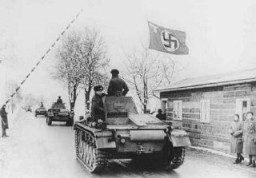
A German guard sitting on the end of a 20mm gun platform watches over 50,000 Soviet Prisoners of War (POWs) at Stalag 349, Ukraine, August 14, 1941.
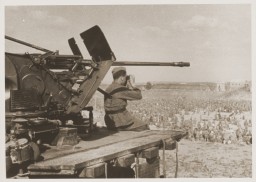
German troops and planes on an improvised airfield during the battle for Norway, May 3, 1940.
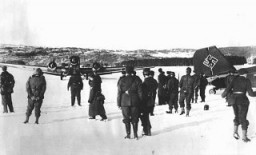
A German motorcycle unit advances through the Bydgoszcz region during the invasion of Poland. September 18, 1939.
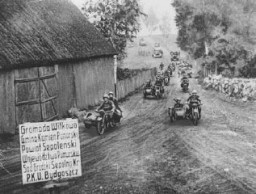
German troops arriving in Norway by ship prepare for landing during the German invasion of Norway. May 3, 1940.
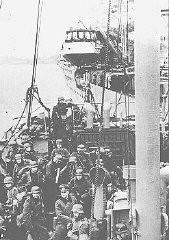
German troops during an anti-partisan operation in Belorussia, 1944.
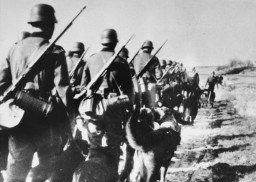
German troops disembarking from a troop transport during the German invasion of Norway. May 3, 1940.

German troops drive in front of a government building during the occupation of Athens following the invasion of the Balkans. Athens, Greece, April 1941.
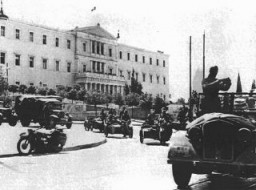
German occupation troops march through the streets of Prague. Czechoslovakia, March 15, 1939.
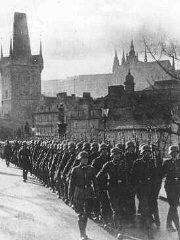
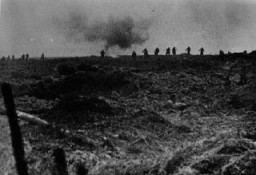
A German army column struggles through the mud, past a destroyed Soviet tank. Nevel, Soviet Union, fall 1943.
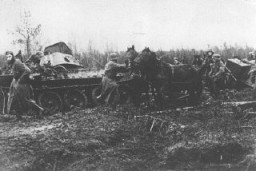
German infantry during the invasion of the Soviet Union in 1941.
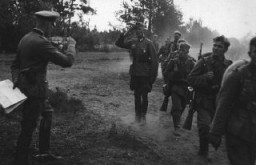
German troops during the invasion of Yugoslavia, which began on April 6, 1941.
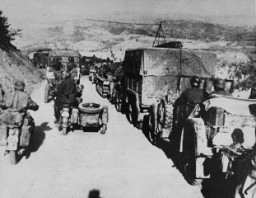
German troops walk past a burning hotel during the invasion of Norway. Norway, April-June 1940.
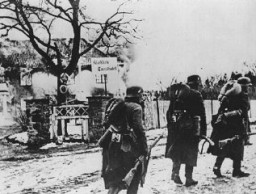

In the aftermath of the Munich agreement, which turned the Sudetenland area of Czechoslovakia over to Germany, German troops march into the town square of Friedland. October 3, 1938.
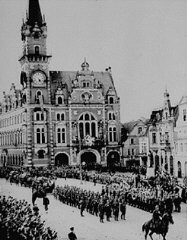
The first German troops to return from the conquests of Poland and France march through the Brandenburg Gate. Berlin, Germany, July 1940.
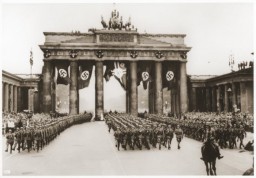
German troops marching into the Sudetenland stop at a former Czech frontier post. Nazi officials and Sudeten Germans salute the troops. The sign between the swastikas reads: "One People, One Reich, One Führer." Grottau, Czechoslovakia, October 2 or 3, 1938.
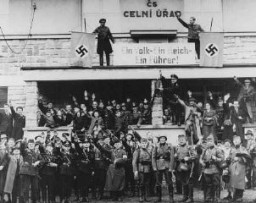

German troops parade through Warsaw after the German invasion of Poland. Warsaw, Poland, September 28-30, 1939.
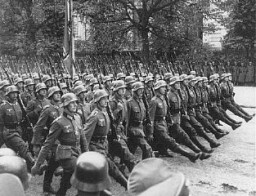
This photograph shows German vehicles that have been loaded on trains headed toward the eastern front to reinforce German forces during the invasion of the Soviet Union in 1941. A German soldier poses in the front car.
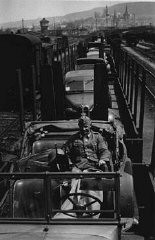
German women at work in the offices of the German Census Bureau. The board gives directions for tabulation: the center column instructs that number 3 is the indicator to be used for Jews. Germany, 1933.
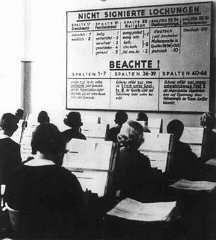
Women were included in preparations for national defense even before the war. Here, some German women form a unit of the civilian Air Defense League. Germany, November 15, 1936.
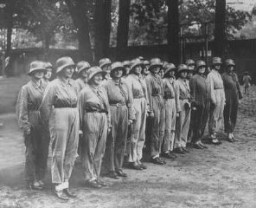
A work corps of German women marches to the fields. Beginning in 1939, many thousands of German women between the ages of 17 and 25 worked on farms as part of a national labor service program. Germany, wartime.
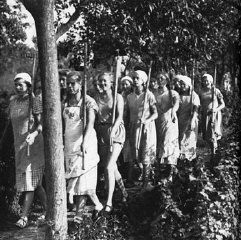
German adults attend a class in racial theory. Germany, date uncertain.
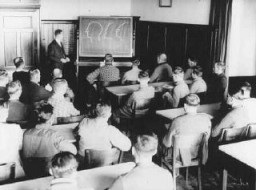
Germans crowd around a truck filled with "un-German" books, confiscated from the library of the Institute for Sexual Science, for burning by the Nazis. The books were publically burned at Berlin's Opernplatz (Opera Square). Berlin, Germany, May 10, 1933.
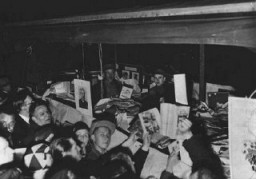
We would like to thank Crown Family Philanthropies, Abe and Ida Cooper Foundation, the Claims Conference, EVZ, and BMF for supporting the ongoing work to create content and resources for the Holocaust Encyclopedia. View the list of donor acknowledgement.